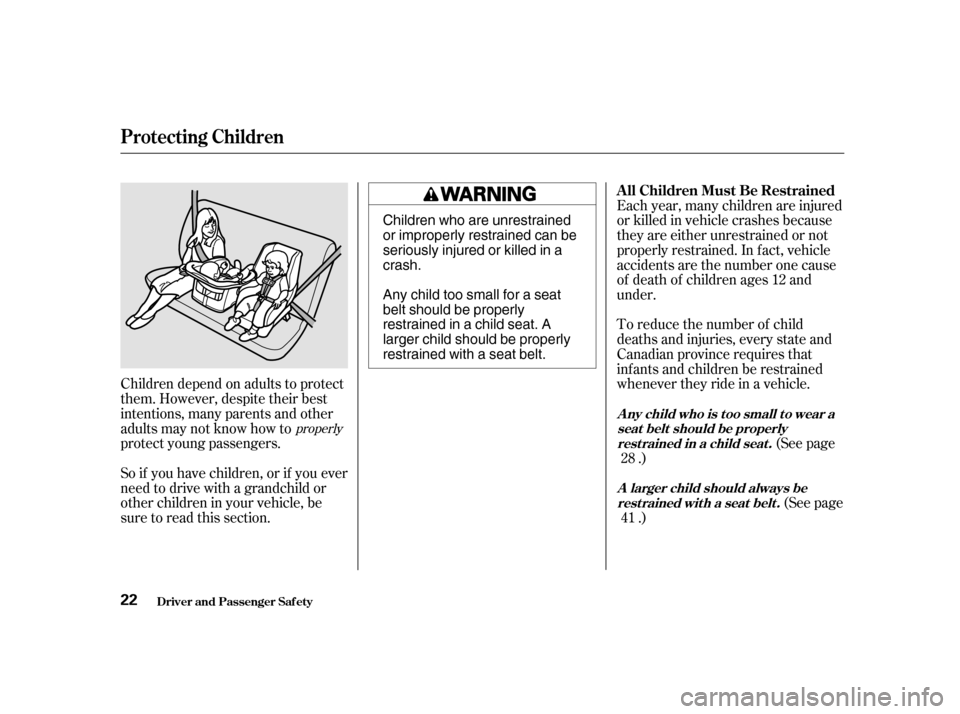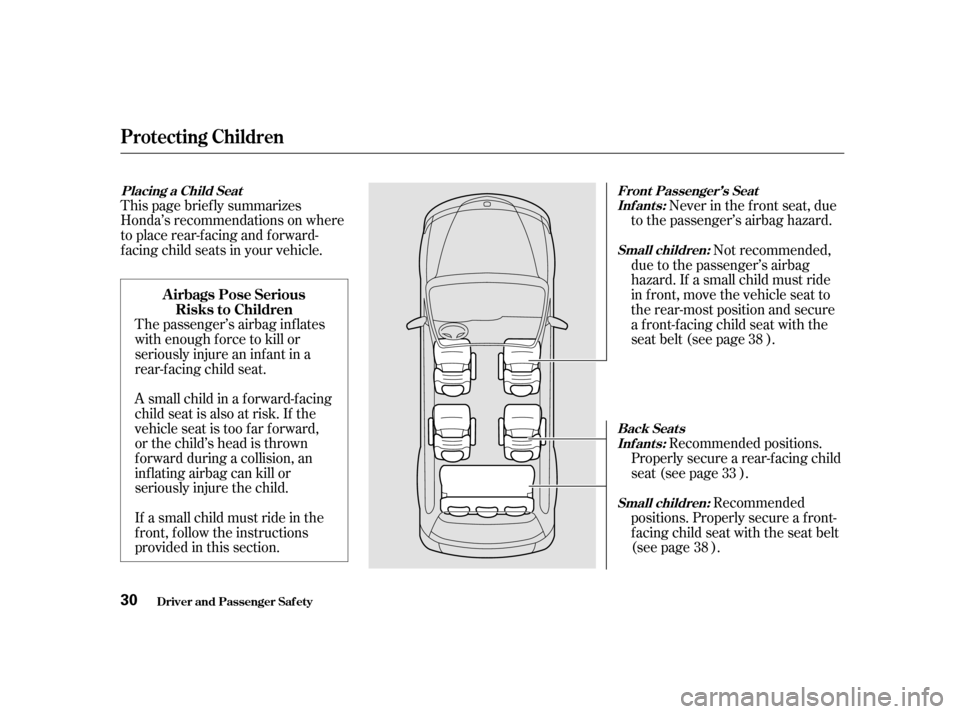Page 20 of 363

If your
hands or arms are close to the
airbag covers in the center of the
steering wheel and on top of the
dashboard, they could be injured if
the airbags inf late.
Carrying hard or sharp objects on
your lap, or driving with a pipe or
other sharp object in your mouth,
can result in injuries if your
airbags inflate. Devices intended to improve
occupant comf ort or reposition the
shoulder part of a seat belt can
severely compromise the
protective capability of the seat
belt and increase the chance of
serious injury in a crash.
Any object
attached to or placed on the covers
marked ‘‘SRS AIRBAG,’’ in the
center of the steering wheel and
on top of the dashboard, could
interf ere with the proper operation
of the airbags. Or, if the airbags
inf late, the objects could be
propelled inside the car and hurt
someone.
Protecting Adults
Driver and Passenger Saf ety
K eep your hands and arms away
f rom t he airbag covers.
Do not place hard or sharp object s bet ween yourself and an airbag.
Do not put any accessories on seat
belts.
Do not at t ach or place object s onthe airbag covers.
21
Page 21 of 363

Children depend on adults to protect
them. However, despite their best
intentions, many parents and other
adults may not know how to
protect young passengers.(See page
.)
(See page
.)
So if you have children, or if you ever
need to drive with a grandchild or
other children in your vehicle, be
sure to read this section. To reduce the number of child
deaths and injuries, every state and
Canadian province requires that
inf ants and children be restrained
whenever they ride in a vehicle.
Each year, many children are injured
or killed in vehicle crashes because
they are either unrestrained or not
properly restrained. In f act, vehicle
accidents are the number one cause
of death of children ages 12 and
under.
2841
properly
All Children Must Be Restrained
Anychildwhoistoosmalltoweara seat belt should be properlyrest rained in a child seat .
A larger child should always berest rained wit h a seat belt .
Protecting Children
Driver and Passenger Saf ety
22 Children who are unrestrained
or improperly restrained can be
seriously injured or killed in acrash.
Any child too small for a seat
belt should be properly
restrained in a child seat. A
larger child should be properly
restrained with a seat belt.
Page 22 of 363

According to accident statistics,
children of all ages and sizes are
saf er when they are restrained in the
back seat, not the f ront seat. The
National Highway Traf f ic Saf ety
Administration and Transport
Canada recommend that all children
ages 12 and under be properly
restrained in a back seat.
In a back seat, children are less
likely to be injured by striking hard
interior parts during a collision or
hard braking. Also, children cannot
be injured by an inf lating airbag
when they ride in the back.
During a
crash, the belt could press deep
into the child and cause very
serious injuries. If you are not wearing a
seat belt in a crash, you could be
thrown f orward into the
dashboard and crush the child.
If youarewearingaseatbelt,the
child can be torn f rom your arms
during a crash. For example, if
your vehicle crashes into a parked
vehicleat30mph(48km/h),a
20-lb (9 kg) inf ant will become a
600-lb (275 kg) f orce, and you will
not be able to hold on.
Protecting Children
Driver and Passenger Saf ety
Children Should Sit in the Back
Seat
Never put a seat belt over yourself
and an inf ant or child.
A ddit ional Precaut ions t o Parent s
Neverholdaninfantorchildonyour lap.
23
Page 23 of 363

Airbags have been designed to help
protect adults in a moderate to
severe f rontal collision. To do this,
the passenger’s airbag is quite large,
and it inf lates with tremendous
speed.If the
airbag inflates, it can hit the back of
the child seat with enough force to
kill or very seriously injure an inf ant. If the vehicle seat is too
f ar f orward, or the child’s head is
thrown f orward during a collision, an
inf lating airbag can strike the child
with enough f orce to kill or very
seriously injure a small child.
Whenever possible, larger
children should sit in a back seat,
properly restrained with a seat belt.
(See page f or important
inf ormation about protecting larger
children.) 41
The Passenger’s Airbag Poses
Serious Risks to Children
Never put a rear-f acing child seat in
t he f ront seat of a vehicle equippedwith a passenger’s airbag.
Inf ant s Small Children
Placing a f orward-f acing child seat int he f ront seat of a vehicle equippedwith a passenger’s airbag can behazardous.
Larger ChildrenChildren who have outgrown childseat s are also at risk of being injuredor killed by an inf lat ing passenger’sairbag.
Protecting Children
Driver and Passenger Saf ety
24
Page 25 of 363

Many parents say they pref er to put
an inf ant or small child in the f ront
passenger seat so they can watch the
child, or because the child requires
attention.
Your vehicle has two rows of back
seats where children can be properly
restrained.
Placing a child in the f ront seat
exposes the child to hazards f rom
the airbag, and paying close
attention to a child distracts the
driver f rom the important task of
driving, placing both of you at risk.
If a child requires physical attention
or f requent visual contact, we
strongly recommend that another
adult ride with the child in a back
seat. The back seat is far safer for a
child than the front.
Place the largest child in the f ront
seat, provided the child is large
enough to wear a seat belt
properly (see page ).
Move the vehicle seat as far to the
rear as possible (see page ).
Have the child sit upright and well
backintheseat(seepage ).
Make sure the seat belt is properly
positioned and secured (see page
).
If you ever have to carry a group of
children (when carpooling f or
example), and a child must ride in
front:
1219
15 41 If a Child Requires Close
Attention
If You Must Drive with Several
Children
Protecting Children
Driver and Passenger Saf ety
26
Page 28 of 363
CONT INUED
Due to variations in the design of
child seats, vehicle seats, and seat
belts, all child seats will not f it all
vehicle seating positions.
However, Honda is conf ident that
one or more child seat models can f it
andbeproperlyinstalledinall
recommended seating positions in
your vehicle.Bef ore purchasing a child seat, we
recommend that parents test the
child seat in the specif ic vehicle
seating position (or positions) where
they intend to use the seat. If a
previously purchased child seat does
not f it, you may need to buy a
different one that will fit.
Your vehicle has lower anchorages
installed f or use with Child Restraint
Anchorage System-compatible child
seats. For more inf ormation, see
page .
47
Protecting Children
Driver and Passenger Saf ety
T he child seat should f it the
vehicle seat ing posit ion (orposit ions) where it will be used.
3.
29
Page 29 of 363

A small child in a f orward-f acing
child seat is also at risk. If the
vehicle seat is too f ar f orward,
or the child’s head is thrown
f orward during a collision, an
inf lating airbag can kill or
seriously injure the child.
If a small child must ride in the
f ront, f ollow the instructions
provided in this section.
The passenger’s airbag inf lates
with enough f orce to kill or
seriously injure an inf ant in a
rear-facing child seat.
This page brief ly summarizes
Honda’s recommendations on where
to place rear-facing and forward-
f acing child seats in your vehicle.
Never in the f ront seat, due
to the passenger’s airbag hazard.
Not recommended,
due to the passenger’s airbag
hazard. If a small child must ride
in f ront, move the vehicle seat to
the rear-most position and secure
a f ront-f acing child seat with the
seat belt (see page ).
Recommended
positions. Properly secure a f ront-
f acing child seat with the seat belt
(see page ). Recommended positions.
Properlysecurearear-facingchild
seat (see page ). 38
33
38
Placing a Child Seat Front Passenger’s Seat
Inf ant s:
Small children:
Back Seat sSmall children:
Inf ant s:
Airbags Pose Serious
Risks to Children
Protecting Children
Driver and Passenger Saf ety
30
Page 30 of 363

Af ter selecting a proper child seat,
and a good position to install the seat,
there are three main steps in
installing the seat:Make sure the child is properly
strappedinthechildseat
according to the child seat maker’s
instructions. A child who is not
properly secured in a child seat
canbethrownoutof theseatina
crash and be seriously injured.
However, a child seat does not need
to be ‘‘rock solid.’’ In some vehicles
or seating positions, it may be
dif f icult to install a child seat so that
it does not move at all. Some side-to-
side or back-and-f orth movement can
be expected and should not reduce
the child seat’s ef f ectiveness. When you are not using a child seat,
either remove it and store it in a saf e
place, or make sure it is properly
secured. An unsecured child seat can
be thrown around the vehicle during
a crash or sudden stop and injure
someone.
If the child seat is not secure, try
installing it in a dif f erent seating
position, or use a dif f erent style of
child seat that can be f irmly secured
in the desired seating position.
To provide security during normal
driving maneuvers as well as during
a collision, we recommend that
parents secure a child seat as f irmly
as possible.
All child seats are
designed to be secured to the
vehicle with the lap part of a lap/
shoulder belt. Some child seats
can be secured to the vehicle’s
lower anchorages instead. A child
whose seat is not properly secured
to the vehicle can be endangered
in a crash. See pages , and for instructions on how to
properly secure child seats in this
vehicle.
Af ter installing a child
seat, push and pull the seat
f orward and f rom side to side to
verif y that it is secure. 38
33
47
Inst alling a Child Seat Secure t he child in t he child seat .
Storing a Child Seat
Properly secure t he child seat t o
the vehicle.
Make sure t he child seat is f irmlysecured.
1.
2. 3.
Protecting Children
Driver and Passenger Saf ety
31